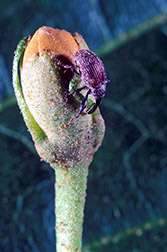No Mistaking this Bug with New Insect ID Technique

(PhysOrg.com) -- Misidentifying boll weevils caught in pheromone traps could be easier to avoid, thanks to a new DNA fingerprinting method devised by Agricultural Research Service (ARS) scientists and their collaborators.
Boll weevils-long-snouted, 2/10-inch-long beetles that damage cotton's lint-producing bolls-are familiar foes to growers. Indeed, since first being discovered in southern Texas in 1892, the boll weevil, Anthonomus grandis, has caused billions of dollars in losses to U.S. cotton. An eradication program that began in 1978 has eliminated the pest from 87 percent of the 15 million acres of American cotton.
Trapping, aided by the use of chemical insect attractants called pheromones, is a key component of the program that can tell where, when, and to what degree boll weevils are present, including those re-invading zones previously cleared of the pest. Field scouts checking pheromone traps sometimes encounter other weevil species, or pieces of trapped weevils that have been partially eaten by insect predators like ants, raising the risk of misidentification. That, in turn, can lead to unnecessary and costly insecticide spraying, according to entomologist Tom Sappington, in the ARS Corn Insects and Crop Genetics Research Unit at Ames, Iowa.
Capitalizing on findings from earlier population genetics studies of the boll weevil, Sappington and colleagues devised a method that uses microsatellite molecular markers to distinguish between the boll weevil and other related species, including pepper, cranberry and pecan weevils.
This characteristic DNA fingerprint, observed on a standard electrophoretic gel, appear as three separate bands, forming a unique barcode-like arrangement of DNA that's specific to boll weevils. These bands are of a specific size and are not shown by non-target weevil species. In tests, the method also identified boll weevils from partial remains, including legs and wings, and yielded results in two days.
Sappington coauthored a paper describing the method in the Journal of Economic Entomology, along with colleagues from Rutgers University in Chatsworth, N.J., Oklahoma State University at Stillwater and the Seoul National University in South Korea.
Provided by Agricultural Research Service
















